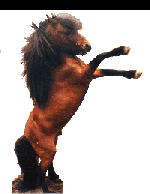|
|||
Nutrition Proper feeding of the miniature horse is critical to the health of your horse. Feeding the horse should be based on their individual needs and work level. Things to consider: lactating mares, age, health, activity schedule, weather, and…. With a standard size horse you feed about 22 pounds of hay plus supplements each day depending on their work load. A miniature horse needs the same nutrients as those big guys but....you cannot give them the same quantity of food. They would pop. The trick is to get the same nutrients in a much smaller package. Any changes in their diet should be done S L O W L Y. The horse has to develop enzymes in their intestines to digest the new feed. This means when you get a new load of food in, you mix the old with the new and feed them half and half to make sure body gets use to the change. When you change brands of pellets, or grain, grass, etc. you will need to go through the same process again. No sudden changes! Use the pellets that are the size of rabbit pellets, they can choke on the large ones. Use grass pellets, mix if that is all you can get in your area, or alpha if that is all there is available. We feed pellets once a day, 3 “measured” cups. When the weather turns colder they will slow down on the water intake. Some of the horses will quit drinking when you take them to a show because the water tastes different. They will come up with a number of reasons not to drink enough water. Add several cups of water to their pellets to add water to their diet if you are not sure. Grass vs AlphaFeed grass for one or more meals a day, feeding out about 2 lbs. per hundred weight of your horse. If you can, avoid alpha. It is pretty and green. It is also too hot and too high in protein. If your horse has a taxing work load they may be able to handle the hotter food. For the average mini’s life style grass would-be a safer option, and could possibly lower the vet bills. When the temperature dips down it will help the horse maintain their body temperature if you feed double the grass during the evening meal. It is not the added hay that keeps them warm. It is the chewing. Horses are grazing animals they were built to eat all day long. If you can you could feed some grass treats in the middle of the day will also cut down on barn, fence, and tree eating. Remember this is not a meal replacement. Be sure to adjust feed for each individual horse. GrainTo the base diet you will need to add a mixed grain. A balanced mix is the best, they need to fats, vitamins, minerals, etc. Pick one with the lowest protein level you can find. A good amount to start with is 1 1/2 cups per day. The best one we have found is Crown Complete Lite. Feeding just oats, just grain, or just corn is not properly balanced and can cause behavioral changes in your horse. That is where the old saying "feeling your oats" comes from. You have gotten your horse stoned! Over feeding "hot" foods will make the babies grow too fast. This often shows up in the horses teeth (jaw) are crooked. Often with a balanced diet the teeth will realign and straighten out. |
|||
 |
Dawg House Ranch |
